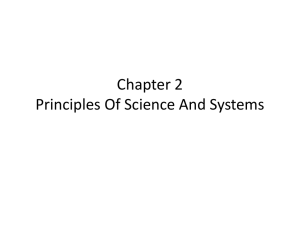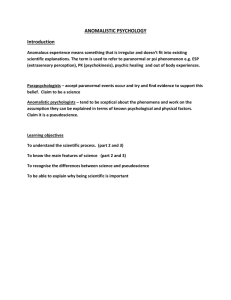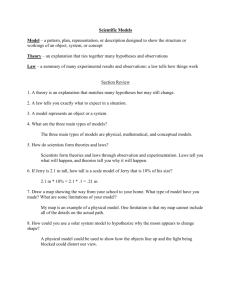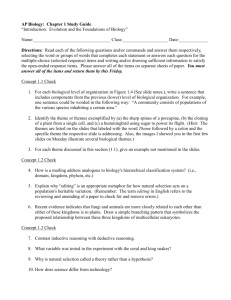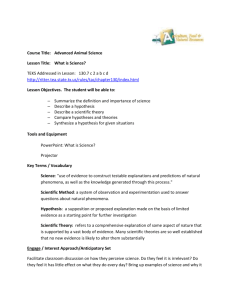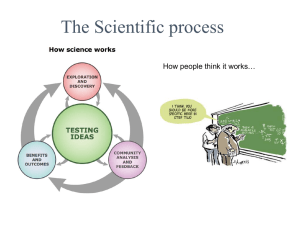Characteristics of Science
advertisement
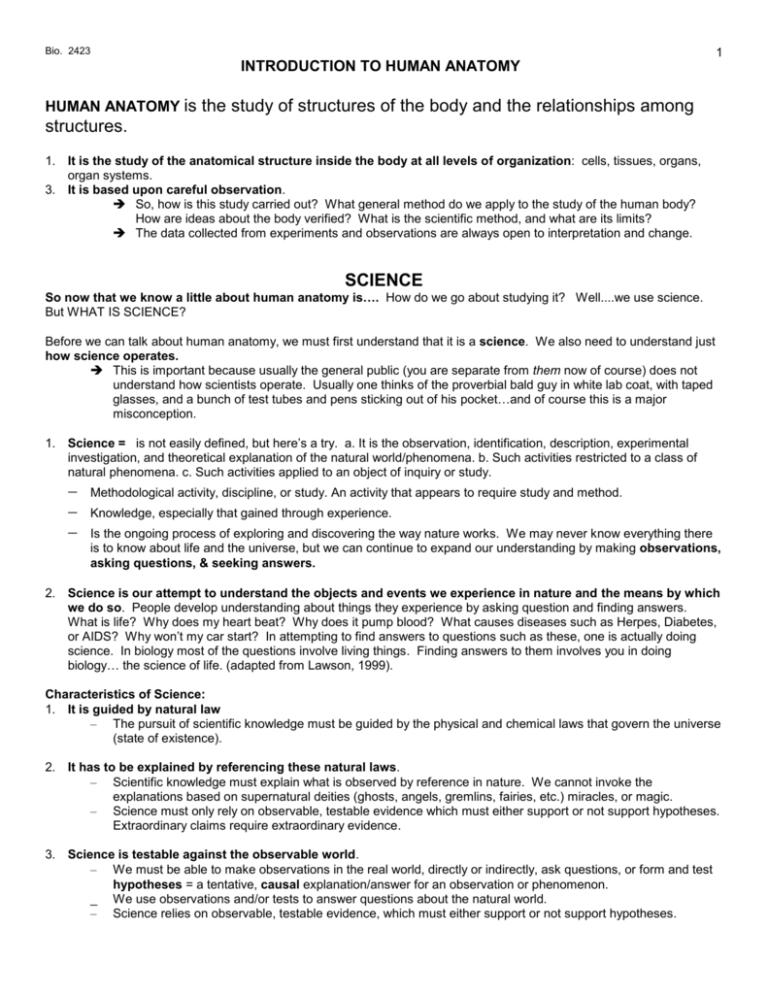
Bio. 2423 1 INTRODUCTION TO HUMAN ANATOMY HUMAN ANATOMY is the study of structures of the body and the relationships among structures. 1. It is the study of the anatomical structure inside the body at all levels of organization: cells, tissues, organs, organ systems. 3. It is based upon careful observation. So, how is this study carried out? What general method do we apply to the study of the human body? How are ideas about the body verified? What is the scientific method, and what are its limits? The data collected from experiments and observations are always open to interpretation and change. SCIENCE So now that we know a little about human anatomy is…. How do we go about studying it? Well....we use science. But WHAT IS SCIENCE? Before we can talk about human anatomy, we must first understand that it is a science. We also need to understand just how science operates. This is important because usually the general public (you are separate from them now of course) does not understand how scientists operate. Usually one thinks of the proverbial bald guy in white lab coat, with taped glasses, and a bunch of test tubes and pens sticking out of his pocket…and of course this is a major misconception. 1. Science = is not easily defined, but here’s a try. a. It is the observation, identification, description, experimental investigation, and theoretical explanation of the natural world/phenomena. b. Such activities restricted to a class of natural phenomena. c. Such activities applied to an object of inquiry or study. Methodological activity, discipline, or study. An activity that appears to require study and method. Knowledge, especially that gained through experience. Is the ongoing process of exploring and discovering the way nature works. We may never know everything there is to know about life and the universe, but we can continue to expand our understanding by making observations, asking questions, & seeking answers. 2. Science is our attempt to understand the objects and events we experience in nature and the means by which we do so. People develop understanding about things they experience by asking question and finding answers. What is life? Why does my heart beat? Why does it pump blood? What causes diseases such as Herpes, Diabetes, or AIDS? Why won’t my car start? In attempting to find answers to questions such as these, one is actually doing science. In biology most of the questions involve living things. Finding answers to them involves you in doing biology… the science of life. (adapted from Lawson, 1999). Characteristics of Science: 1. It is guided by natural law – The pursuit of scientific knowledge must be guided by the physical and chemical laws that govern the universe (state of existence). 2. It has to be explained by referencing these natural laws. – Scientific knowledge must explain what is observed by reference in nature. We cannot invoke the explanations based on supernatural deities (ghosts, angels, gremlins, fairies, etc.) miracles, or magic. – Science must only rely on observable, testable evidence which must either support or not support hypotheses. Extraordinary claims require extraordinary evidence. 3. Science is testable against the observable world. – We must be able to make observations in the real world, directly or indirectly, ask questions, or form and test hypotheses = a tentative, causal explanation/answer for an observation or phenomenon. _ We use observations and/or tests to answer questions about the natural world. – Science relies on observable, testable evidence, which must either support or not support hypotheses. Bio. 2423 2 4. Its conclusions are tentative, that is, are not necessarily the final word. _ If we draw a conclusion based on some observation or test on some event, we must be ready always to discard or to modify our conclusion, if further observations falsify it. _ Can’t be scientific if you start with a conclusion and refuse to change it regardless of the evidence developed during the course of the investigation. 5. It is falsifiable. You must be able to disprove any statement. If there is no possibility that the statement cannot be correct, then it isn’t science. What this means is that science will seek out errors and correct them. Unlike other philosophies, it’s a self-correcting system. We add to and take away information on a daily basis depending on new discoveries and new evidence. 6. It relies on evidence that is testable (from observations and experimentations). If we cannot make repeated observations or experiments to gather information, then it is outside the realm of science (e.g. UFO’s, haunted houses, etc.). 7. One cannot ever prove things true or false in science. Probability plays a role, as do critical values. 8. Correlation does not imply Causation. Just because the price of beans in China goes up when the Dalllas Cowboys football team loses does NOT mean the loss caused the bean prices to go up Important Criteria for Determining… What is Science?: The following “rules” are also very important in determining what is and what isn’t science. If a claim/fact or study does not follow these “rules,” then it isn’t science. 1. 2. 3. 4. 5. Science is logical & rational Science makes well-defined claims Scientific hypotheses are falsifiable, as in testable. Scientific experiments are repeatable Science requires that claims be examined by peers in the same field 6. Science views unexplained gaps in theories with suspicion 7. 8. 9. 10. 11. Science requires evidence & caution in examining it Science requires objectivity (open-mind) Science does not accept coincidence as proof Science doe not accept anecdotal evidence as proof Science insists that extraordinary claims require extraordinary evidence 12. Absence of evidence is not evidence of absence THE SCIENTIFIC METHOD 1. Everything we are going to study this semester from cells to reproduction is based on careful scientific investigation as produced by what is called the scientific method. It is not infallible, but is in fact, designed to be open to change and modification. 2. The Scientific Method is a method of collecting evidence through observation, questioning, hypothesis formation, and hypothesis testing (often through experimentation). One then examines the results and forms a conclusion and repeats the process, if necessary. It is therefore a step by step approach to investigating the natural world. – All scientific investigation begins with an observation of the natural world. This also includes examining any previous info. that is published in the scientific literature. – On the basis of this observation, the scientist asks a question. – The scientist then proposes a causal explanation to the question (aka hypothesis). The hypothesis is tentative and may be changed based on the outcome of rigorous testing. – Hypothesis testing is done by making further observations or conducting experiments. – The results of such testing either confirm or contradict the hypothesis. – Conclusions are then reached based on the results. – If it is contradicted, the hypothesis is discarded and a new one is generated. Example: One could use the scientific method to test the effects of exercise of the resting heart rate on teenagers. Example: You use the scientific method in everyday life; (e.g. to figure out why your flashlight won’t work, car won't start etc.) Bio. 2423 3 THE SCIENTIFIC METHOD AND EXPERIMENTAL DESIGN: 1. 2. 3. 4. Observation: An artificial sweetener is known to cause some cells to divide rapidly? Question: Will artificial sweetener, given to rats, cause them to have bladder cancer? Hypothesis: Rats given artificial sweetener will develop bladder cancer (e.g. the sweetner is the cause) Experiment: Two groups (one with sweetener = treatment group; one without = control group) Define Dependent Variable: Define the Independent Variable: Define Controls: Number of Replicates: Sample Size: Define Biases. Results & Conclusions: (Presentation/Publication/Peer-Review) 5. New hypothesis? ALTERNATE ROUTES TO DISCOVERY: Although many discoveries have followed just such a series of steps, many others have not. Most great scientific achievements are the result of creative genius, diligence, and many long hours of dedicated research. However, some revolutionary discoveries are simply the result of accident or flashes of insight, as in the following examples: Some discoveries have been made by accident: Alexander Fleming in 1928, while trying to discover a cure for the flu left some open petri dishes by an open window. He discovered a green mold growing on them. Thinking his expt. was ruined he noticed the bacteria on the dish were killed by this green mold. Led to the discovery of penicillin (after the name of the mold Peniclliun notatum). Some by pure observation. Behavior of hyenas and lions. Flashes of Insight: Sir Isaac Newton had an apple fall on his head which sparked a connection that had never been made before---that the force, which pulled the apple to the ground, is also responsible for helping to hold the moon and planets together in their places = gravity. He eventually supported his supposition (hypothesis) mathematically. People used to think that the forces on heavenly bodies were different from those affecting earthly ones. Yet, even though a great deal of scientific inquiry does not follow these steps, “the scientific method” forms the general ground rules that scientists use to formulate explanations (hypotheses) for how nature works, to test the accuracy of those explanations, and to report the finings so that others can benefit from the new information. SOME COMMON MISCONCEPTIONS: In general a fact in science can mean 2 things (1) an observation or (2) a statement concerning a direct observation of nature that is so consistently replicated (repeated) that virtually no doubt exists as to its validity. for example. Mitochondria manufacture ATP; the heart pumps blood; red blood cells carry oxygen bound to hemoglobin. There’s also a HUGE, I mean HUGE difference between a theory & hypothesis in scientific lingo vs. the general public. There’s also a HUGE, I mean HUGE difference between a theory & hypothesis in scientific lingo vs. the general public. Scientific theories are (1) collections of statements (tested hypotheses) about the natural world which can consistently explain naturally occurring phenomena and predict new events. (2) They are built up logically from testable observations and hypotheses. (3) They are based on numerous facts and experiments that have been tested large numbers of times and yielded statistically, consistent results (withstood the test of time). As such, they are very powerful scientific statements. (4) They serve as a logical framework by which these hypotheses can be interrelated and provide the basis for predictions that may as yet be untested. For example many theories have great predictive power, i.e., one can formulate new hypotheses for testing in a broad framework for investigating the natural world in a number of areas. (e.g cell theory, atomic theory, photosynthetic theory, gravitational theory, evolutionary theory, wave theory of light etc.). (5) Theories are the goals of science. This is vastly different from what the public thinks when they hear the word “theory.” In general when most people hear this word they think of a “best guess” or “idea”. This is a valid definition, but very different from the scientific definition of the word. Because scientific theories are backed by repeated tests and numerous observations (literally thousands, even millions) they are not mere speculations or guesses, as the term is sometimes popularly used. Yet, in science even the most trusted theories must withstand the challenge of further experimentation and observation. This is how scientific Bio. 2423 4 progress is made, by correcting mistakes/ finding errors/ clarifying inconsistencies and adding to our collective body of knowledge. Cool huh! When you hear on the TV show CSI: Las Vegas or Miami, “Can you prove your theory?” They are incorrect on two counts. Can you explain why? Laws are generalizations that describe phenomena; whereas, theories explain phenomena. For example, the laws of thermodynamics describe what will happen under certain circumstances; thermodynamics theories explain why these events occur. Laws, like facts and theories, can change with better data. But theories do not develop into laws with the accumulation of evidence. Rather, theories are the goal of science." 2. Example: The first law of thermodynamics states that energy can neither be created nor destroyed. (Just changes form). The second law of thermodynamics states that without the input of energy, entropy is ever increasing in the universe. Thermodynamic theories explain how and why these occur. CORRELATION VS. CAUSATION LIMITS OF SCIENCE: 1. Neither the body of scientific information nor the methods of science can answer certain questions. Science cannot determine whether God exists, what is moral or immoral, what is ethical or unethical. For example, science cannot say it is immoral to destroy vast rain forests or abort a human fetus. These are all areas that depend on personal experience and value judgment. 2. However, science can identify changes and predict consequences, and humans can form personal judgments about those consequences. Example: What will happen if the rain forests are destroyed? Example: What are the physiological and psychological consequences of an abortion? 3. Because science deals only with repeatable phenomena, brief, unpredictable, and unrepeated events (such as “miracles” and “ghosts”) cannot be investigated well by science. They exist in the realm of “pseudo-science.” Fantastic claims like these (or UFO’s or even Bigfoot) are extraordinary, and as such they would require extraordinary evidence for their existence? (Are photographs and personal testimony enough for you)? 4. A WORD about Believing vs. Knowing. Critical Thinking Rules & Science When analyzing an article, claim, advertisement, issue, or fact, you may find it useful to employ these rules: 1. Gather complete information about the claim/fact/observation. Is it plausible? 2. Understand and define all terms about the claim/fact/observation. 3. Question the methods by which data and information were derived? Were the facts derived from experiments? Were the experiments well executed? Did the experiment include a control group and an experimental group? Did the experiment include a sufficient number of subjects or replicates? Has the experiment been repeated? 4. Question the conclusions: Are the conclusions appropriate? Was there enough information on which to base the conclusions? 5. Uncover assumptions and biases (= any influence or action that distorts the findings or slants them away from what is actually true or expected): Are there any biases? If so what are they? Was the experimental design biased? How so? What could/should have been done differently? Are there underlying assumptions that affect the conclusions? Bio. 2423 5 6. Question the source of the information and/or the author: Is the source reliable? Is he/she stating opinion or fact? Are the facts valid/verifiable? Is the source an expert or supposed expert? How do you know? What are the qualifications/experiences of the supposed expert? Do they have valid credentials from a recognized, accredited academic institution? What questions would you have for the author? Did he/she have an agenda? Something to prove? Is there anything you would consider unethical or dangerous? 7. Check the references/literature cited. Are the references valid and verifiable? Are they from peer-reviewed journals? If web resources are cited, are they accurate and credible? 8. Examine the big picture. Does it make sense in the grand scheme of things? 9. Look for multiple causes and effects. (Are there other things that could explain the results?) 10. Understand your own biases and values. How could your personal values affect your view of the issue, fact, statement, or conclusions? PSEUDOSCIENCE Pseudoscience fails to meet the criteria met by science generally (including the scientific method), and can be identified by a combination of these characteristics by: * * * * * * * * * * * asserting claims, hypotheses, or theories without first verifying them in experiments. asserting claims which cannot be verified. asserting claims without supporting experimental evidence. asserting claims which contradict experimentally established results. failing to provide an experimental possibility of reproducible results. claiming a theory predicts something that it does not. claiming a theory predicts something that it has not been shown to predict. discrediting one theory based on rhetoric and no factual evidence. discrediting an established explanation with no factual evidence for the alternative or not having an alternative explanation asserting claims that violate falsifiability. violating Occam's Razor (the principle of choosing the explanation that requires the fewest additional assumptions when multiple viable explanations are possible); the more egregious the violation, the more likely. Pseudoscience is distinguishable from revelation, theology or spirituality in that it claims to offer insight into the physical world by "scientific" means. Systems of thought that rely upon "divine" or "inspired" knowledge are not considered pseudoscience if they do not claim to be scientific or to overturn well-established science. There are also bodies of practical knowledge that are not claimed to be scientific. These are not pseudoscience. Pseudoscience is also distinguishable from misleading statements in some Popular science, where commonly held beliefs are thought to meet the criteria of science, but often don't. The issue is muddled, however, because it is believed that "pop" science blurs the divide between science and pseudoscience among the general public. Examples of fields of endeavor that many consider – to varying extents – pseudoscientific include Cold fusion, Götaland theory, pseudoarchaeology, Gene Ray's Time Cube, astrology, homeopathy, and creationism. Pseudoscientific science and medical practices are often quite popular. Medical pseudosciences even sometimes show notable therapeutic benefits, possibly due to the placebo effect or observer bias. Many pseudosciences are associated with the New Age movement and there is a tendency to improperly associate all practices of the "New Age" with pseudoscience. Certain "watchdog" groups, such as CSICOP, have released statements expressing concern about the apparent growing popularity of pseudoscience, especially when it applies to scientific fields that are intended to save people's lives. A number of self-proclaimed alternative medicine treatments have been designated pseudoscience by critics, largely because some of these methods inspire false hope in terminally ill patients, and end up costing large amounts of money without actually providing any real benefit, treatment, or cure for various ailments.

